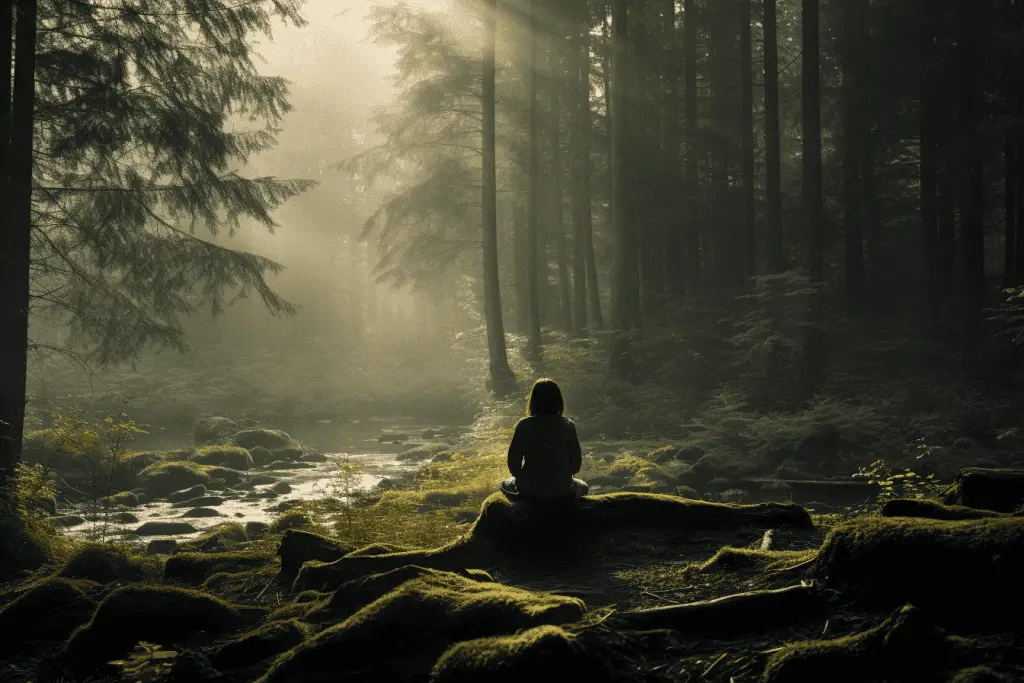Studies have shown that there is a wide range of benefits to forest bathing, but what is forest bathing?
Forest bathing, or “shinrin-yoku” in Japanese, is the practice of immersing oneself in nature, specifically in forests, to enhance well-being. It involves mindfully observing and connecting with the natural environment to reduce stress and boost health.

Key Principles of Forest Bathing
Shinrin-yoku, which translates to “forest bathing”, isn’t about taking a dip in a woodland pond or a vigorous hike through the woods. It’s more of a mindful immersion into nature. The core idea is to be present, to really tune into the surroundings, and let the forest environment wash over your senses.
The first principle is simplicity. There’s no specific agenda, no route, and no distance to be covered. Think of it as taking a leisurely stroll, letting curiosity guide you. If a shimmering leaf catches your eye or a distant birdcall grabs your ear, you pause and savor the experience.
Next, it’s about connectivity. Forest bathing aims to bridge the gap between us and the natural world. It’s a gentle reminder that we are a part of this intricate web of life, not separate from it. By touching, smelling, and even tasting the forest, we form a deeper bond with nature.
Lastly, stillness plays a pivotal role. Every so often during your forest bath, you might just stop, sit, and simply be. This stillness allows the forest’s tranquil ambiance to seep in, rejuvenating the mind and spirit. It’s nature’s therapy, pure and simple.
Physical Health Benefits of Forest Bathing
Forest bathing, or shinrin-yoku, offers numerous physical health benefits backed by scientific studies. Here are some of the most prominent ones:
- Boosted Immune System: According to New York’s Department of Environmental Conservation, spending time in forests has been shown to increase the number and activity of natural killer cells, which play a significant role in warding off infections and combating diseases like cancer.
- Reduced Blood Pressure: The calming effect of nature helps lower cortisol levels, the body’s primary stress hormone. This can lead to reductions in blood pressure, beneficial for cardiovascular health.
- Decreased Stress: The serene ambiance of the forest, coupled with the act of being present in nature, effectively reduces physiological markers of stress.
- Improved Sleep Quality: Regular forest bathers often report better sleep. This might be linked to reduced stress levels and the calming influence of nature on the mind.
- Reduced Inflammation: Chronic inflammation can lead to various ailments, including heart diseases, diabetes, and certain cancers. Nature immersion has been associated with lower inflammatory markers.
- Enhanced Energy and Vitality: Breathing in the fresh forest air, rich in natural phytoncides (natural compounds produced by trees), can increase energy levels and overall feelings of well-being.
- Improved Lung Health: Forests, especially coniferous ones, emit essential oils and beneficial compounds that can boost lung health and offer a refreshing respiratory experience, especially for city dwellers who are used to more polluted environments.
- Better Cardiovascular Health: The combination of physical activity (like walking) with the stress-reducing effects of nature can be beneficial for heart health.
While the act of walking and moderate exercise during forest bathing plays a role in these health benefits, the unique environment and the mindful immersion in forests provide additional therapeutic advantages. It’s no wonder that forest bathing is becoming a popular prescription for overall wellness in many parts of the world.
The Mental Health Benefits of Forest Bathing
In addition to physical benefits, forest bathing has profound impacts on mental well-being. Here’s how it benefits our minds:
- Stress Reduction: Immersion in nature helps lower cortisol levels, which are directly linked to stress. The calming sights and sounds of the forest provide a natural antidote to the hustle and bustle of daily life.
- Improved Mood: Nature has a soothing effect on the mind. Regular forest bathers often report feeling happier and more refreshed after their outings. It’s believed that the environment helps alleviate symptoms of depression and anxiety.
- Enhanced Focus and Concentration: Spending time in nature, away from digital distractions, can rejuvenate our attention span and improve concentration. It’s a form of natural ‘reset’ for our often overstimulated brains.
- Boosted Creativity: The serenity of the forest can unlock creative thoughts. By taking a break from daily routines and immersing ourselves in nature, we allow our minds the freedom to wander, dream, and innovate.
- Enhanced Mindfulness: Forest bathing promotes being present in the moment. By attuning ourselves to the sights, sounds, and textures around us, we practice mindfulness, which has numerous cognitive and emotional benefits.
- Reduction in Mental Fatigue: Nature acts as a restorative environment for our brains. The simplicity and beauty of nature scenes are restful for our minds, offering a break from the complexities of urban environments.
- Emotional Resilience: Regular encounters with nature can help us cope better with adversity. The vastness and persistence of nature often give people a broader perspective on their personal challenges, making them seem more manageable.
- Connection and Belonging: Forest bathing nurtures a sense of connectivity, not just with nature but also with oneself. It helps individuals understand their place in the larger web of life, fostering feelings of belonging and purpose.
In an age where mental health issues are on the rise, largely due to urbanization, hectic lifestyles, and constant digital connectivity, forest bathing emerges as a simple, yet profound, therapeutic practice. It’s nature’s own way of healing, grounding, and rejuvenating the human spirit.
How to Practice Forest Bathing
Diving into forest bathing? Great choice! It’s simpler than you might think, and there’s no special equipment required. The primary goal? Connect with nature in a mindful way. Let’s break it down.
Start by choosing a natural area that speaks to you. It could be a dense forest, a local park, or even a garden. Once there, leave behind distractions. That means turning off your phone, or at least putting it on silent. This isn’t about snapping Instagram-worthy photos; it’s about immersing yourself in the moment.

Now, begin your walk slowly. There’s no rush, no distance goal, no target spot to reach. Allow your senses to guide you. Maybe the scent of a particular plant draws you in, or the rustling of leaves in the breeze captures your attention. Go where your curiosity leads.
Remember to engage all your senses. Feel the texture of tree bark, listen to the chirping of birds, smell the damp earth or fragrant pines. You can even taste the fresh air! This multisensory approach helps you connect more deeply with your surroundings.
Finally, find a spot to sit and simply be. Allow the tranquility of nature to wash over you. Close your eyes, take a deep breath, and let the forest work its magic. Think of this as a nature meditation. When you’re done, return from your forest bath feeling rejuvenated and reconnected with the world around you.
Finding a Good Spot for Forest Bathing
Picking the perfect spot for forest bathing is like finding that cozy corner in a café where everything just feels right. It’s about personal comfort and connection. Don’t know where to start? No worries, let’s map it out.
Your best bet is to begin locally. Explore nearby parks, nature reserves, or woodlands. Proximity matters because the easier it is to access, the more likely you’ll make it a regular practice. While dense forests are ideal, even a community green space can work wonders. It’s less about the spot’s grandeur and more about its tranquility and your connection to it.

As you explore, look for areas that naturally draw you in. Maybe it’s a clearing with a view, a path alongside a babbling brook, or a canopy of trees that offers just the right amount of shade. The spot should feel inviting, a place where you can comfortably sit, wander, or even lie down.
Lastly, consider time and ambiance. Early mornings or late afternoons might offer fewer crowds and a softer, more golden light. But the right time is truly whenever you can steal a quiet moment. Remember, it’s all about immersing yourself and tuning into nature’s rhythm. So, lace up those walking shoes and embark on a mini adventure to find your ideal immersion spot!
Forest Bathing Tips
Here are some tips to ensure a rewarding forest bathing experience:
- Dress Comfortably: Wear clothing suitable for the weather and terrain. Consider layers that can be easily added or removed.
- Leave Tech Behind: While it might be tempting to capture the moment, smartphones and gadgets can distract. If you must bring your phone, keep it on silent.
- Go Solo or With Like-minded Company: Solo trips can be deeply introspective, but if you prefer company, ensure it’s someone who shares the intent of the experience.
- Stay Hydrated: Bring a water bottle. Staying hydrated will help you remain comfortable and present.
- Start Slow: Resist the urge to walk fast. The goal isn’t distance but immersion. Let your senses guide your pace.
- Engage All Senses: Touch the textures around you, listen closely to natural sounds, and inhale the various aromas.
- Avoid Overplanning: While it’s good to know where you’re going, remain open to unexpected detours or spots that call to you.
- Stay Safe: Familiarize yourself with the area, watch for trip hazards, and if you’re in an unfamiliar forest, consider a map or a compass.
- Practice Mindful Breathing: Take deep breaths, focusing on the rhythm of your breathing. This can enhance relaxation and connection.
- Limit Expectations: Every experience can be different. Embrace whatever feelings or observations come to you without judgment.
- Respect Nature: Leave no trace behind. This ensures that the serene environment remains intact for others and for future visits.
- Regular Practice: Like meditation or exercise, the more regularly you practice forest bathing, the more profound its benefits can be.
Lastly, remember that forest bathing is a personal journey. There’s no “right” way to do it, only your way.
